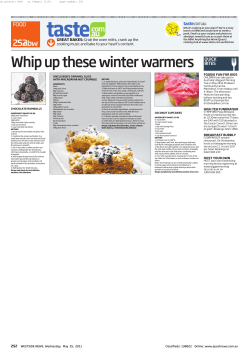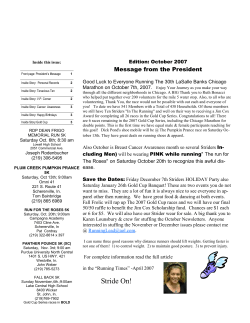
giving back
giving back Taste f o o d Fall for Winter Squash With the cooler weather arrives this charming, versatile vegetable dressed in the warm colors of the season. Summer squash has faded from the garden. The replacement? Centerpiece-worthy winter squash with its organic shapes, varying sizes, and fall colors inside and out. For Suzanne Goin, chef and co-owner of Lucques, A.O.C., Tavern, and The Larder at Maple Drive—all in Los Angeles—its appearance signals the arrival of fall and the holidays. (She’s also behind an as-yet-unnamed farm-to-table restaurant slated to open in Montecito in the spring—lucky us!) “Winter squash is the poster child of the season,” she says. I couldn’t agree more. Come fall, I stock up on pumpkins, but I also snap up yellow delicata squash with green stripes and deep-green striped kabocha. At area farmers’ markets and produce stands you’ll find all sorts of squash, from the familiar butternut and acorn to the less common heirloom Turk’s Turban and red kuri. Check out Underwood Family Farms (underwoodfamilyfarms.com) in Moorpark and Somis as well as Tutti Frutti Farms (tuttifruttifarms.com) in Lompoc for interesting varieties. As the squash roasts and the aroma fills my kitchen, my thoughts turn to Thanksgiving menus, and then I keep going. As long as it’s chilly outside, the earthy sweetness, colorful orange or golden flesh, and what Goin describes as the “unexpected diversity and charm” of squash are a welcome sight. Winter squash can move between savory and sweet dishes and can be roasted, baked, pureed, sautéed, or steamed. Plus, the seeds can be toasted for a snack or salad topper. At Thanksgiving, this versatility means that cooks can insert a squash dish into the family’s traditional menu or switch up the usual squash offering. On my holiday table, butternut squash 74 n ov e m b e r 2 0 1 2 805living.COM soup with citrus shrimp and cilantro from years past will step aside for Goin’s Kabocha Squash and Fennel Soup With Crème Fraîche and Candied Pumpkin Seeds from Sunday Suppers at Lucques: Seasonal Recipes From Market to Table (Knopf, 2005), which she wrote with Teri Gelber (recipe on page 76). The squat, round kabocha featured in the soup is Goin’s favorite type of squash. “It has the sweetness you expect from winter squash but it’s also nutty and sort of earthy, which really balances the sweetness,” she says. Beyond the flavor, Goin relishes its “dense and rich, almost meaty” texture. “I have paired many things with kabocha,” adds Goin, ticking off ingredients such as dates, Parmesan, pepitas, and dandelion greens. “Earthy, nutty grains like farro and dark greens like kale also go well,” she says. To accentuate the vegetable’s savoriness, she roasts thick kabocha wedges tossed with olive oil, thyme, and sometimes rosemary. On the flip side, Goin could play up the squash’s sweetness with brown butter, cinnamon, and a bit of honey. Wide-ribbed acorn squash—green, yellow, mottled, or white—is another of Goin’s favorites. “It gets big points for the cute shape and size,” she says. Because this variety has a lighter, fresher flavor, Goin tends toward pairing it with fresh herbs and spinach or other light greens. As an added benefit, a halved and hollowed-out acorn squash is a natural for filling with everything from soup to stuffing (see the Winter Squash Stuffing recipe on page 76). What’s more, low-cal winter squash is chock-full of antioxidants, which might help prevent heart disease and some types of cancer, as well as fiber, vitamins, and minerals. > James Carrier/StockFood Creative/Getty Images by Sarene Wallace Playing With Squash As the weather cools, area chefs warm up their menus with winter squash. The dishes are as varied as the different types of squash, ranging from salads and soups to purees and pasta. Acorn squash sourced from Fairview Gardens (fairviewgardens.org) in Goleta turns into a seasoned puree served alongside Monterey Bay black cod on the seasonal menu at Miró, the signature restaurant at Bacara Resort & Spa (bacararesort.com) in Santa Barbara. The apples, onions, butter, cinnamon, and cayenne that accompany the baking squash are also in the puree. Swiss chard, candied bacon, beets, and bacon vinaigrette complete the plate. At Arts & Letters Café (artsandletterscafe. com) in Santa Barbara, chef Avery Hardin turns local butternut squash into a pureed soup seasoned with butter, yellow onions, and salt. His straightforward approach enhances the squash’s flavor, he says. Hardin’s Thanksgivingworthy Winter Squash Stuffing recipe on page 76 was created especially for 805 Living. Farmstand 46 (farmstand46.com) in Templeton grows its own butternut and acorn squash for its just-picked fall menu. Head chef Jeremiah Bradley has a ready supply for his Gruyère cream sauce lasagna that includes roasted butternut squash and porcini mushrooms. Roasted butternut or acorn squash go into a salad with toasted walnuts and goat cheese, depending on what’s ripe that day, he says (see his Acorn Squash Salad on page 76). Then there’s the medley of roasted vegetables, including thinly sliced acorn squash, which fills The Badger sandwich. At Mediterraneo (med-rest.com) in Westlake Village, executive chef Lisa Biondi serves a starter of roasted acorn squash wedges and creamy burrata. It’s topped with balsamic brown butter, toasted hazelnuts, and crispy sage. From there, move on to baked pasta with butternut squash, Tuscan kale, and Italian sausage. Executive chef Charles Weber at Adelina’s Bistro & Market Place (adelinasbistro.com) at the Monarch Club at Trilogy Monarch Dunes in Nipomo, roasts chunks of many different winter squash varieties for a side dish accented with ricotta salata. Right before serving, he tops it with a thin ribbon of honey and olive oil. 805living.COM n ov e m b e r 2 0 1 2 75 Taste f o o d KABOCHA SQUASH AND FENNEL SOUP WITH CRÈME FRAÎCHE AND CANDIED PUMPKIN SEEDS This soup is a “lovely way to start the Thanksgiving meal,” says chef and restaurateur Suzanne Goin of Lucques, A.O.C., Tavern, and The Larder at Maple Drive, all in Los Angeles. She’s also a partner in an upcoming farmto-table restaurant in Montecito. The recipe comes courtesy of Sunday Suppers at Lucques: Seasonal Recipes From Market to Table (Knopf, 2005), which Goin wrote with Teri Gelber. 2 pounds kabocha squash 2 medium bulbs fennel 4 tablespoons extra-virgin olive oil 2 teaspoons fennel seeds of the broth. (You will need to puree the soup in batches.) Process at the lowest speed until the squash mixture is pureed. Add another ½ cup broth and then turn the speed up to high and pour in more liquid, a little at a time, until the soup has the consistency of heavy cream. Blend at least a minute on high speed, until the soup is completely smooth and very creamy. Transfer to a container, and repeat with the rest of the ingredients. You may not need all the liquid. Taste for balance and seasoning. Pour the soup into six bowls, spoon some crème fraîche in the center of each, and scatter the pumpkin seeds over the top. Or serve familystyle in a tureen with the crème fraîche and pumpkin seeds on the side. Serves 6. 4 tablespoons unsalted butter 2 cups sliced onions 1 tablespoon thyme leaves 2 chiles de árbol 1 bay leaf ¾ cup sherry 10 cups chicken or vegetable stock or water ¼ cup crème fraîche Candied Pumpkin Seeds (recipe follows) Kosher salt and freshly ground black pepper Preheat the oven to 400°F. Cut the squash in half lengthwise, and remove the seeds. Place the squash cut side down on a cutting board, and use a sharp knife to remove the peel. Slice the squash into 1-inch-thick wedges. Cut the fennel in half lengthwise and then into ½-inch-thick wedges. Toss the squash and fennel with the olive oil, 1 teaspoon salt, and some freshly ground black pepper. Place the vegetables flat on a baking sheet and roast about 35 minutes, until tender and slightly caramelized. Meanwhile, toast the fennel seeds in a small pan over medium heat 2 to 3 minutes, until the seeds release their aroma and are lightly browned. Pound them coarsely in a mortar. Heat a Dutch oven or soup pot over high heat for 2 minutes. Add the butter, and when it foams, add the onions, fennel seeds, thyme, chiles, bay leaf, 1 teaspoon salt, and a good amount of freshly ground black pepper. Reduce the heat to medium-high, and cook about 10 minutes, stirring often, until the onions are soft, translucent, and starting to color. CANDIED PUMPKIN SEEDS ¼ teaspoon cumin seeds 2 teaspoons unsalted butter ½ cup raw pumpkin seeds 1 tablespoon granulated sugar Generous pinch each of ground cinnamon, paprika, and cayenne pepper 1 teaspoon honey Kosher salt Toast the cumin seeds in a small pan over medium heat 2 to 3 minutes, until the seeds release their aroma and are lightly browned. Pound them coarsely in a mortar. Melt the butter in the cumin pan over medium heat. Add the pumpkin seeds and sugar, then sprinkle the spices and a healthy pinch of salt over them. Toss the pumpkin seeds to coat them well with the butter, and cook a few minutes, until just after they begin to pop and color slightly. Turn off the heat, and wait 30 seconds. Add the honey, tossing well to coat the pumpkin seeds. Spread on a plate and let them cool. Makes about ½ cup. WINTER SQUASH STUFFING This recipe comes courtesy of chef Avery Hardin of Arts & Letters Café (artsandletterscafe.com) in Santa Barbara. 3 medium acorn squash (about 1½ pounds each), halved lengthwise and seeds removed 3 tablespoons unsalted butter, melted Add the squash and fennel, and stir to coat with the onions for a minute. Turn the heat back up to high and pour in the sherry. Let it reduce for a minute or two, and then add the stock and 1 tablespoon salt. Bring to a boil, turn down the heat, and simmer 20 minutes. 1 tablespoon packed dark brown sugar Strain the soup in a colander set in a pot. Put a third of the solids into a blender with ½ cup 2 cups cooked wild rice mix (from 1 cup uncooked) ½ medium yellow onion, finely chopped 4 celery stalks, finely chopped 76 n ov e m b e r 2 0 1 2 805living.COM 2 medium shallots, finely chopped 1 tablespoon minced fresh thyme leaves 2 ⁄ 3 cup pecans, toasted and finely chopped ¼ cup dried cranberries, finely chopped 1 teaspoon kosher salt, plus more as needed ½ teaspoon freshly ground black pepper, plus more as needed Heat the oven to 450°F and arrange a rack in the middle position. Place squash cut side up on a baking sheet. Brush 1 tablespoon of the melted butter over the tops and insides of the squash halves, sprinkle with brown sugar, and season with salt and freshly ground black pepper. Roast in the oven until just fork tender, about 25 to 30 minutes. Meanwhile, place 1 tablespoon of the melted butter in a large frying pan over medium heat. When it foams, add the onion, shallots, and celery, season with salt and freshly ground black pepper, and stir to coat. Cook, stirring occasionally, until just softened, about 6 minutes. Stir in the thyme and cook until just fragrant, about 1 minute. Remove from heat and stir in the rice, pecans, cranberries, and measured salt and pepper. Divide the rice filling among the roasted squash halves (about ½ cup for each half) and drizzle the remaining tablespoon of butter over. Continue roasting until each is completely fork tender, the edges have started to brown, and the filling is heated through, about 20 to 25 minutes. Serves 6. ACORN SQUASH SALAD This recipe comes courtesy of Jeremiah Bradley, head chef of Farmstand 46 (farmstand46.com) in Templeton, who says the salad also can be made with butternut squash. He leaves the skin on for color but says if the squash is not roasted long enough, the skin can be tough. Or peel the skin off with a vegetable peeler, if desired. 2 acorn squash ½ cup walnut pieces ½ cup fresh goat cheese (such as Montchevré) ¼ cup fresh herbs (such as rosemary, thyme, oregano, and sage) ½ cup extra-virgin olive oil, divided Salt and pepper, to taste Preheat oven to 350°F. Cut each acorn squash in half and clean out seeds. Then, cut squash into ½-inch dice. Place diced squash into a bowl and toss with ¼ cup olive oil, salt, and pepper. Transfer to a baking sheet and bake for 30 minutes or until fork tender. Let cool. Place walnuts on another baking sheet and bake for 15 minutes or until you can smell the walnuts. Take out and let cool. Once squash and walnuts are cool, combine with fresh goat cheese, fresh herbs, remaining ¼ cup extra-virgin olive oil, salt, and pepper. Serves 4 to 5.
© Copyright 2025

















